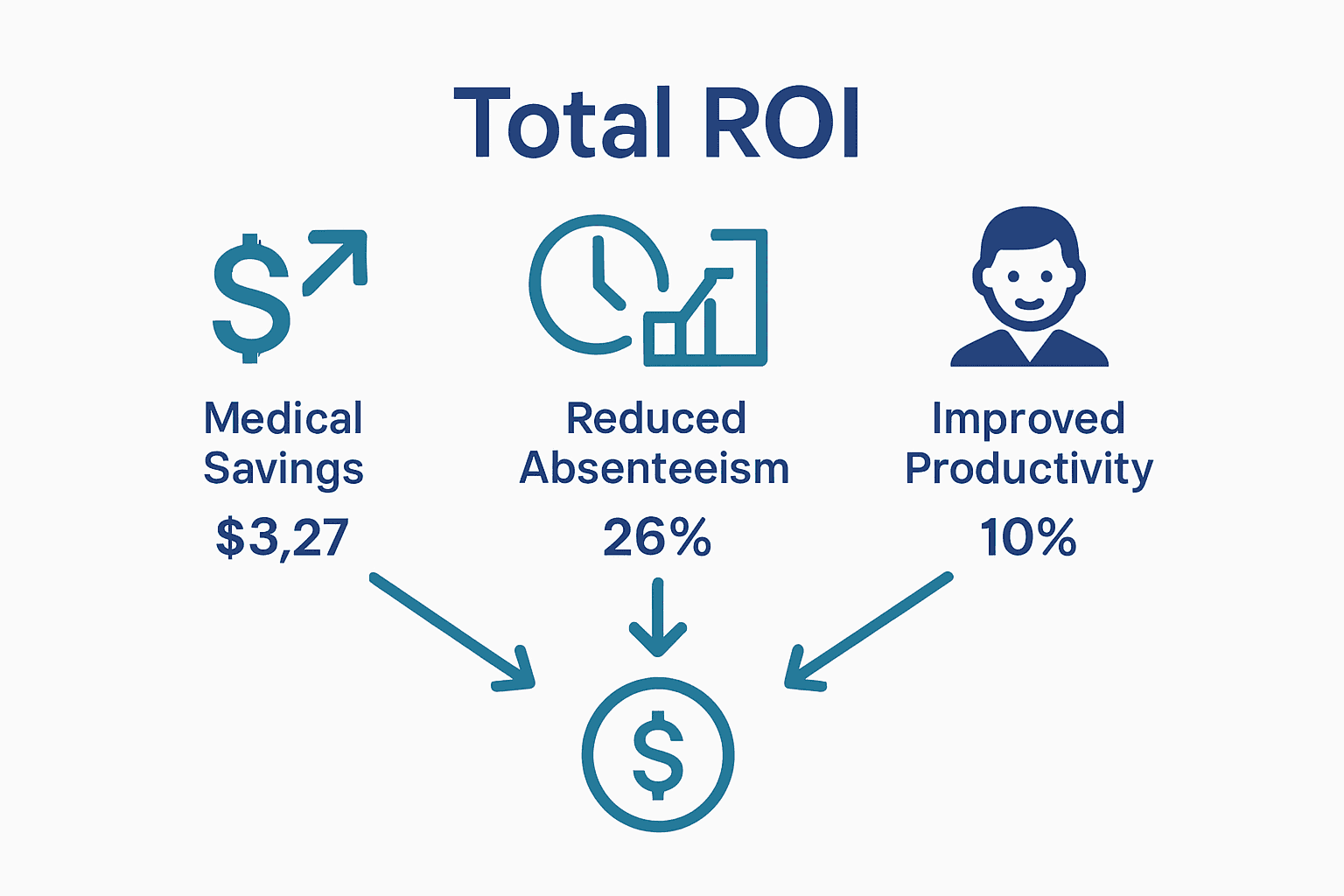Did you know that businesses with comprehensive wellness programs see an average ROI of 47 percent and report up to 25 percent lower employee turnover? As the connection between wellbeing and workplace performance grows stronger, organizations now look beyond traditional healthcare to support their people. Smart companies blend fitness, mental health, and financial wellness efforts, recognizing that thoughtful investment pays off with happier employees and a healthier bottom line.
Key Takeaways
| Point | Details |
|---|---|
| Holistic Wellness Programs | Employee wellness programs focus on comprehensive health support, integrating physical, mental, and financial wellness to enhance overall wellbeing and workplace performance. |
| Personalized Strategies | Successful initiatives recognize diverse employee needs, enabling tailored approaches that foster a supportive workplace culture and improve retention. |
| Legal Compliance | Employers must navigate complex regulations to ensure wellness programs meet privacy and non-discrimination standards while encouraging voluntary participation. |
| ROI from Wellness Initiatives | Organizations can expect substantial financial returns, with studies indicating potential returns of $3.27 in medical savings for every $1 invested in wellness programs. |
Table of Contents
- Defining Employee Wellness Programs And Benefits
- Types Of Wellness Programs For Businesses
- Core Elements Of Effective Wellness Initiatives
- Legal Requirements And Compliance Issues
- Evaluating Costs And Roi For Employers
Defining Employee Wellness Programs and Benefits
An employee wellness program represents a strategic initiative designed to support and improve workers’ physical, mental, and emotional health. These comprehensive programs go beyond traditional healthcare benefits, focusing on holistic approaches that enhance overall employee wellbeing and organizational performance.
At their core, wellness programs typically encompass multiple dimensions of health support:
- Physical health screenings and assessments
- Mental health resources and counseling services
- Fitness and nutrition guidance
- Stress management workshops
- Financial wellness education
- Work life balance initiatives
According to recent academic research from ArXiv Research, proactive mental health interventions can significantly reduce workplace challenges. The study highlights that stress and poor mental health directly contribute to increased absenteeism and employee attrition. By implementing real-time mental health support mechanisms like stress detection systems, organizations can potentially minimize sick days and improve overall workforce resilience.
Successful wellness programs recognize that employee health is multifaceted. They integrate personalized strategies that address individual needs while creating a supportive workplace culture. The goal isn’t just reducing healthcare costs, but genuinely investing in employees’ comprehensive wellbeing - transforming workplace environments into spaces that nurture personal and professional growth.
Types of Wellness Programs for Businesses
Wellness programs have evolved into diverse, comprehensive strategies that address multiple dimensions of employee health. Organizations today recognize that a one-size-fits-all approach doesn’t work, leading to the development of targeted wellness initiatives that cater to different employee needs and preferences.
According to research from Built In, businesses typically implement wellness programs across three primary categories:
Physical Wellness Initiatives
- Gym membership reimbursements
- On-site fitness classes
- Biometric health screenings
- Healthy food options in workplace cafeterias
- Walking challenge competitions
Mental Health Support
- Employee Assistance Programs (EAPs) offer confidential counseling services
- Mindfulness and meditation applications
- Stress management workshops
- Counseling hotlines
- Mental health days
Financial Wellness Resources
Here’s a summary of the primary types of wellness program initiatives:
| Category | Example Offerings | Main Benefits |
|---|---|---|
| Physical Wellness | Gym reimbursement Health screenings Fitness classes |
Improved health Lower absenteeism |
| Mental Health Support | EAPs Counseling Mindfulness apps |
Reduced stress Higher retention |
| Financial Wellness | Retirement planning Loan assistance |
Less financial stress Better focus |
- Retirement planning workshops
- Financial literacy training
- Student loan repayment assistance
- Investment education seminars
- Personalized financial coaching
Research highlights the critical role of Employee Assistance Programs (EAPs), which provide confidential, voluntary services available 24/7. Wikipedia notes these programs offer counseling, assessments, and referrals for personal and work-related issues, ultimately helping improve productivity and reduce workplace absenteeism.
Effective wellness programs are not about implementing every possible initiative, but strategically selecting interventions that resonate with your specific workforce demographics and organizational culture. The key is creating a supportive environment that demonstrates genuine commitment to employee wellbeing.

Core Elements of Effective Wellness Initiatives
Wellness initiatives are not just checkbox exercises but strategic programs requiring careful design and holistic implementation. Successful programs go beyond superficial interventions, embedding comprehensive support systems that genuinely address employee needs across multiple dimensions of wellbeing.
Key core elements that define effective wellness programs include:
- Leadership Commitment: Active endorsement and participation from top management
- Personalization: Tailored approaches matching diverse workforce demographics
- Comprehensive Coverage: Addressing physical, mental, and financial wellness
- Continuous Measurement: Regular assessment of program effectiveness
- Cultural Integration: Wellness embedded as part of organizational values
According to groundbreaking research from ArXiv, flexible working arrangements represent a critical component of modern wellness strategies. The study reveals that flexible work options significantly boost employee motivation, reduce burnout, improve job satisfaction, enhance loyalty, increase productivity, and strengthen employer branding.
Strategic Implementation Principles
Effective wellness programs require a multifaceted approach:
- Conduct thorough employee needs assessments
- Design targeted, evidence-based interventions
- Ensure confidentiality and voluntary participation
- Provide accessible, user-friendly wellness resources
- Create ongoing engagement and communication channels
Ultimately, successful wellness initiatives transcend traditional benefit packages. They represent a genuine organizational commitment to employee wellbeing, recognizing that supporting workers’ holistic health directly correlates with improved performance, retention, and overall workplace satisfaction.
Legal Requirements and Compliance Issues
Wellness programs operate within a complex legal landscape that requires careful navigation to protect both employer and employee rights. Understanding the regulatory framework is crucial for developing compliant and ethical wellness initiatives that respect individual privacy and prevent discrimination.
Key legal considerations for wellness programs include:
- HIPAA Compliance: Protecting personal health information
- Non-Discrimination Guidelines: Ensuring equal access and treatment
- Voluntary Participation: Preventing mandatory involvement
- Data Privacy Protections: Securing sensitive health data
- Reasonable Accommodations: Supporting employees with disabilities
According to Corporate Wellness Magazine, employers must meticulously manage health information collection. This involves:
- Limiting access to personal health data
- Implementing secure storage mechanisms
- Ensuring strict confidentiality protocols
- Obtaining explicit employee consent
Critical Regulatory Frameworks
Employers must navigate multiple regulatory requirements enforced by agencies like the Equal Employment Opportunity Commission (EEOC). These regulations specifically prohibit discrimination based on:
- Age
- Disability status
- Genetic information
- Protected medical conditions
Successful wellness programs strike a delicate balance between gathering meaningful health insights and protecting individual employee rights. The goal is creating supportive environments that offer valuable health resources without compromising personal privacy or creating potential legal vulnerabilities.
Evaluating Costs and ROI for Employers
Return on Investment (ROI) for wellness programs extends far beyond simple financial calculations. Modern organizations recognize these initiatives as strategic investments that generate substantial long-term value through improved employee performance, reduced healthcare expenses, and enhanced organizational culture.
Financial Impact Metrics
Research from the U.S. Chamber of Commerce reveals compelling financial benefits:
- Average ROI: 47% in 2022 (projected 52% by 2026)
-
Return Breakdown:
- Productivity gains
- Medical cost reductions
- Tax benefits
- Talent retention savings
According to detailed studies, employers can expect significant financial advantages:
- 10-15% lower healthcare claims within three years
- 17% higher productivity
- 21% increased profitability
- Up to 25% reduction in employee turnover
Remarkable Insight: For every $1 invested, organizations can save $3.27 in medical costs and $2.73 in absenteeism expenses.
Successful wellness programs transform from cost centers to strategic investments.
 By holistically addressing employee health, companies create environments that simultaneously support individual wellbeing and organizational performance. The key is implementing data-driven, targeted initiatives that demonstrate measurable economic and human capital returns.
By holistically addressing employee health, companies create environments that simultaneously support individual wellbeing and organizational performance. The key is implementing data-driven, targeted initiatives that demonstrate measurable economic and human capital returns.
Enhance Employee Wellness With Safer, Healthier Workspaces
Addressing employee wellness means going beyond programs and workshops. If your facility struggles with high stress and absenteeism, look at the physical environment too. The article highlights that true wellness is holistic, integrating support for both mental and physical wellbeing. One area businesses often overlook is the significant impact that workplace comfort and safety have on overall employee satisfaction, productivity, and retention.
Upgrade your spaces with durable mat solutions from Mats4U. Comfortable, anti-fatigue, and slip-resistant mats can reduce accidents, enhance comfort for staff on their feet all day, and create a safer environment in high-traffic areas. Invest in your team’s wellbeing now by exploring our commercial matting options and discover how you can make an immediate difference. Take the next step to support your wellness initiatives and place your order with Mats4U today at https://mats4u.com. Your team’s health and morale depend on the quality of their workspace. Act now to demonstrate your commitment and enjoy the benefits of a safer, healthier workplace.
Frequently Asked Questions
What are employee wellness programs?
Employee wellness programs are strategic initiatives designed to support and improve the physical, mental, and emotional health of employees, focusing on holistic approaches that enhance overall wellbeing and organizational performance.
What types of initiatives are commonly included in wellness programs?
Wellness programs typically include physical health initiatives like gym memberships and fitness classes, mental health support such as Employee Assistance Programs (EAPs) and counseling services, and financial wellness resources like retirement planning and financial literacy training.
How do wellness programs benefit employers?
Wellness programs provide significant benefits to employers, including reduced healthcare costs, lower employee turnover, increased productivity, and enhanced organizational culture, often resulting in a substantial return on investment (ROI).
What legal considerations should organizations keep in mind when implementing wellness programs?
Organizations must navigate various legal aspects, including HIPAA compliance, non-discrimination guidelines, ensuring voluntary participation, protecting data privacy, and providing reasonable accommodations for employees with disabilities.
Recommended
- Understanding Employee Break Room Ideas for Better Workplaces – Mats4U USA
- Understanding Reducing Workplace Stress: Key Concepts – Mats4U USA
- Understanding Sustainable Workplace Practices for Business Success – Mats4U USA
- Understanding Ergonomics in the Workplace – Mats4U USA
- Understanding Employee Wellness Programs and Their Benefits – The Ocean Straw







